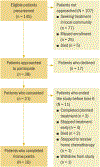Understanding Symptom Burden in Patients With Advanced Cancer Living in Rural Areas
- PMID: 31225835
- PMCID: PMC6642634
- DOI: 10.1188/19.ONF.428-441
Understanding Symptom Burden in Patients With Advanced Cancer Living in Rural Areas
Abstract
Objectives: To evaluate the feasibility of using a biobehavioral approach to examine symptom burden in rural residents with advanced cancer.
Sample & setting: 21 patients with advanced lung, colorectal, or pancreatic cancer were enrolled at the University of Iowa in Iowa City.
Methods & variables: Using Cleeland's cytokine-immunologic model of symptom expression, symptom burden (i.e., severity, count, and interference) and inflammatory cytokines were measured for 24 weeks. Potential predictors included demographics, clinical characteristics, optimism, social support, and cancer-related stress. Descriptive statistics, Wilcoxon rank-sum, and Fisher's exact test were used for analysis.
Results: Recruitment and retention rates were similar for rural and nonrural patients. Demographics, optimism, and social support were no different between groups. The cancer-related stress total score for rural patients was nearly half of the score of nonrural patients, with rural patients reporting significantly less avoidance. Symptom severity for the five worst symptoms remained moderate during the 24 weeks, whereas nonrural residents reported steady declines in severity of their five worst symptoms. Significant differences in inflammatory cytokines between groups were only found at one time point.
Implications for nursing: Rural residents who seek care at a cancer center may be clinically and demographically more similar to their nonrural counterparts than to rural residents seeking local care.
Keywords: advanced cancer; isolation; rural; symptom burden; symptom management.
Similar articles
-
Sociodemographic and Clinical Factors Associated With Radiation Treatment Nonadherence and Survival Among Rural and Nonrural Patients With Cancer.Int J Radiat Oncol Biol Phys. 2023 May 1;116(1):28-38. doi: 10.1016/j.ijrobp.2022.06.075. Epub 2022 Jun 29. Int J Radiat Oncol Biol Phys. 2023. PMID: 35777674 Free PMC article.
-
"Just Living With Them": Symptom Management Experiences of Rural Residents With Advanced Cancer.Oncol Nurs Forum. 2019 Sep 1;46(5):531-542. doi: 10.1188/19.ONF.531-542. Oncol Nurs Forum. 2019. PMID: 31424451
-
Diagnosing cancer in the bush: a mixed-methods study of symptom appraisal and help-seeking behaviour in people with cancer from rural Western Australia.Fam Pract. 2013 Jun;30(3):294-301. doi: 10.1093/fampra/cms087. Epub 2013 Jan 30. Fam Pract. 2013. PMID: 23363540
-
Association of Financial Strain With Symptom Burden and Quality of Life for Patients With Lung or Colorectal Cancer.J Clin Oncol. 2016 May 20;34(15):1732-40. doi: 10.1200/JCO.2015.63.2232. Epub 2016 Feb 29. J Clin Oncol. 2016. PMID: 26926678 Free PMC article.
-
Rural/nonrural differences in colorectal cancer incidence in the United States, 1998-2001.Cancer. 2006 Sep 1;107(5 Suppl):1181-8. doi: 10.1002/cncr.22015. Cancer. 2006. PMID: 16802323
Cited by
-
Disparities in Psychosocial Distress Screening and Management of Lung and Ovarian Cancer Survivors.JCO Oncol Pract. 2022 Oct;18(10):e1704-e1715. doi: 10.1200/OP.22.00078. Epub 2022 Aug 8. JCO Oncol Pract. 2022. PMID: 35939778 Free PMC article.
-
Rural residence is related to shorter survival in epithelial ovarian cancer patients.Gynecol Oncol. 2021 Oct;163(1):22-28. doi: 10.1016/j.ygyno.2021.07.035. Epub 2021 Aug 13. Gynecol Oncol. 2021. PMID: 34400004 Free PMC article.
-
A glycosylation-related signature predicts survival in pancreatic cancer.Aging (Albany NY). 2023 Nov 30;15(23):13710-13737. doi: 10.18632/aging.205258. Epub 2023 Nov 30. Aging (Albany NY). 2023. PMID: 38048216 Free PMC article.
-
Machine learning-informed liquid-liquid phase separation for personalized breast cancer treatment assessment.Front Immunol. 2024 Nov 19;15:1485123. doi: 10.3389/fimmu.2024.1485123. eCollection 2024. Front Immunol. 2024. PMID: 39628476 Free PMC article.
-
A Cross-Sectional Analysis of Ambulatory Oncology Experience by Treatment Intent.Curr Oncol. 2020 Dec 18;28(1):98-106. doi: 10.3390/curroncol28010013. Curr Oncol. 2020. PMID: 33704180 Free PMC article.
References
-
- Aouizerat BE, Dodd M, Lee K, West C, Paul SM, Cooper BA, … Miaskowski C (2009). Preliminary evidence of a genetic association between tumor necrosis factor alpha and the severity of sleep disturbance and morning fatigue. Biological Research for Nursing, 11, 27–41. 10.1177/1099800409333871 - DOI - PubMed
-
- Blake KD, Moss JL, Gaysynsky A, Srinivasan S, & Croyle RT (2017). Making the case for investment in rural cancer control: An analysis of rural cancer incidence, mortality, and funding trends. Cancer Epidemiology, Biomarkers and Prevention, 26, 992–997. 10.1158/1055-9965.epi-17-0092 - DOI - PMC - PubMed
Publication types
MeSH terms
Grants and funding
LinkOut - more resources
Full Text Sources
Medical


